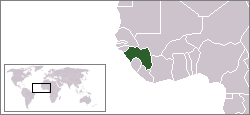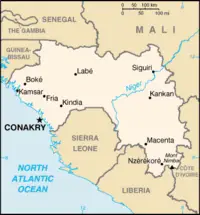Guinea
| République de Guinée Republic of Guinea | |||||
| |||||
| Motto: "Travail, Justice, Solidarité" (French) "Work, Justice, Solidarity" | |||||
| Anthem: "Liberté" | |||||
| Capital (and largest city) |
Conakry 9°31′N 13°42′W | ||||
| Official languages | French | ||||
|---|---|---|---|---|---|
| Government | Republic | ||||
| - President | Lansana Conté | ||||
| - Prime Minister | Eugène Camara | ||||
| Independence | |||||
| - from France | October 2, 1958 | ||||
| Area | |||||
| - Total | 245,857 km² (78th) 94,926 sq mi | ||||
| - Water (%) | negligible | ||||
| Population | |||||
| - July 2005 estimate | 9,402,000 | ||||
| - 1996 census | 7,156,406 | ||||
| - Density | 38/km² 98/sq mi | ||||
| GDP (PPP) | 2005 estimate | ||||
| - Total | $18.879 billion | ||||
| - Per capita | $2,035 | ||||
| HDI (2004) | |||||
| Currency | Guinean franc (GNF)
| ||||
| Time zone | GMT (UTC) | ||||
| Internet TLD | .gn | ||||
| Calling code | +224 | ||||
Guinea, officially Republic of Guinea , is a nation in West Africa formerly known as French Guinea. Guinea's territory has a curved shape, with its base at the Atlantic Ocean, inland to the east, and turning south. The base borders Guinea-Bissau and Senegal to the north, and Mali to the north and northeast; the inland part borders Côte d'Ivoire to the southeast, Liberia to the south, and Sierra Leone to the west of the southern tip. It encompasses the water source of the Niger, Senegal, and Gambia rivers. The name Guinea is used for the region of most of Africa's west coast south of the Sahara Desert and north of the Gulf of Guinea. Guinea is a version of the Berber word aguinaw, meaning black man. Guinea is sometimes called Guinea-Conakry per its capital, to differentiate it from the neighboring Guinea-Bissau (whose capital is Bissau).
History
The land today's Guinea occupies has been part of a series of empires, beginning with the Ghana Empire which came into being c. 900. This was followed by the Sosso kingdom in the twelfth and thirteenth centuries. The Mali Empire came to power in the area after the Battle of Kirina in 1235 and prospered until internal problems weakened it, and its states seized power in the fifteenth century. One chief state was the Songhai state, which became the Songhai Empire. It exceeded its predecessors in territory and wealth, but it too fell prey to internal wrangling and civil war and was eventually toppled at the Battle of Tondibi in 1591.
Then the area fragmented until an Islamic state was founded in the eighteenth century, bringing some stability to the region. Another important event was the arrival of Fulani Muslims in the highland region of Fuuta Jalloo in the early eighteenth century.
Europeans came to the area during the Portuguese discoveries that started the slave trade, beginning in the fifteenth century.
Present-day Guinea was created as a colony by France in 1890. The capital Conakry was founded on Tombo Island in 1890. In 1895 the country was incorporated into French West Africa.
On September 28, 1958, under the direction of Charles de Gaulle, France held a referendum on a new constitution and the creation of the Fifth Republic. Its colonies were given a choice between immediate independence and the new constitution. All except Guinea voted for the new constitution. Thus, Guinea became the first French African colony to gain independence, at the cost of the immediate ending of all French assistance.
After independence Guinea was governed by dictator Ahmed Sékou Touré. Touré pursued broadly socialist economic policies and suppressed opposition and free expression with little regard for human rights. After his death in 1984, Lansana Conté took power and immediately changed the economic policies but kept the close grip on power. The first elections were held in 1993, but their results and those of subsequent elections were disputed. Conté faces regular criticism for the condition of the country's economy and for his heavy-handed approach to political opponents.
Guinea still faces very real problems; according to the International Crisis Group, it is in danger of becoming a failed state. President Conté sacked his prime minister in April 2006 and failed to appoint a new one until the end of January 2007. During 2006, there were two strikes by city workers, both quickly resolved by conceding more favorable wages to city employees, and ten students were killed to squelch a demonstration, ending that minor uprising. However, by the beginning of 2007, trade unions called new strikes to protest rising living costs, government corruption, and economic mismanagement. These strikes drew some of the largest demonstrations seen during Conté's tenure and resulted in over a hundred deaths and large-scale destruction. After initially appointing a prime minister seen as an ally, Conte eventually accepted a candidate proposed by the Economic Community of West African States (ECOWAS): Lansana Kouyate, a former UN under secretary-general. Another positive sign is that the Parliament overturned the state of emergency that Conte had declared.
Politics
Guinea has had only two presidents since independence was declared on October 2, 1958. Under Ahmed Sékou Touré the country went into political and economic isolation as a consequence of the withdrawal of French assistance. This lasted until economic nessecity called for an opening of the economy in 1978 [1]. Lansana Conté took control of the country in 1984 after the death of Sekou Touré. Conté was elected president in 1993, then again in 1998 and 2003. But the validity of those elections is contested, since Conté has not tolerated potential adversaries.
The unicameral People's National Assembly has 114 seats; members are elected by direct, popular vote to serve five-year terms.
Administrative divisions
Guinea is divided into seven administrative regions and subdivided into thirty-three prefectures. The national capital, Conakry, ranks as a special zone. The regions are Boké, Faranah, Kankan, Kindia, Labé, Mamou, Nzérékoré and Conakry.
Geography
Guinea is roughly the size of the United Kingdom and slightly smaller than the states of Michigan or Oregon. There are 200 miles (320 km) of coastline. The total land border is 2,112 miles (3,399 km). The countries bordering Guinea include Côte d'Ivoire (Ivory Coast), Guinea-Bissau, Liberia, Mali, Senegal, and Sierra Leone.
The country is divided into three main regions: the lowlands along the coast, the mountains that run roughly north-south through the country, and the forested jungle regions in the south and east. Guinea's mountains are the source for the Niger, Gambia, and Senegal Rivers, as well as the numerous rivers flowing to the sea on the west side of the range in Sierra Leone and Ivory Coast.
The highest point in Guinea is Mont Nimba at 5,748 ft (1,752 m). Although the Guinean and Ivorian sides of the Nimba Massif are a UNESCO Strict Nature Reserve, a portion of the so-called Guinean Backbone continues into Liberia, where it has been mined for decades.
Economy
Guinea possesses major mineral, hydroelectric, and agricultural resources, yet remains an underdeveloped nation. The country possesses over 30 percent of the world's bauxite reserves and is the second-largest bauxite producer. The mining sector accounts for about 70 percent of exports.
Long-run improvements in government fiscal arrangements, literacy, and the legal framework are needed if the country is to move out of poverty. Investor confidence has been sapped by rampant corruption, a lack of electricity and other infrastructure, a lack of skilled workers, and the political uncertainty due to the failing health of President Conté. Guinea is trying to reengage with the IMF and World Bank, which cut off most assistance in 2003, and is working closely with technical advisors from the U.S. Treasury Department, the World Bank, and IMF, seeking to return to a fully funded program. Growth rose slightly in 2006, primarily due to increases in global demand and commodity prices on world markets, but the standard of living fell. The Guinea franc depreciated sharply as the prices for basic necessities like food and fuel rose beyond the reach of most Guineans. Dissatisfaction with economic conditions prompted nationwide strikes in 2006 and 2007.
In September 2006, the government signed a production-sharing contract with an American company to explore for offshore petroleum resources.
In 2006, Transparency International ranked Guinea as the most perceived corrupt nation in Africa and one of the most corrupt countries in the world, ranking only before Myanmar, Iraq and Haiti.
Transportation
The railroad that used to operate from Conakry to Bamako in Mali has been abandoned. As of 2006, all travel is by plane or automobile. Most vehicles in Guinea are some twenty years old, and cabs are any four-door vehicle the owner has designated as for hire. Locals, nearly entirely without vehicles of their own, rely upon these taxis (which charge per seat) and small buses to take them around town and across the country. Horses and donkeys are also found pulling carts, though this is primarily used to transport construction materials.
Demographics
The majority (85 percent) of the population is Muslim, with Christians 8 percent and indigenous beliefs 7 percent.
Culture
Like other West African countries, Guinea has a rich musical tradition. The group Bembeya Jazz became popular in the 1960s. The Vancouver-based guitarist Alpha Yaya Diallo hails from Guinea and incorporates its traditional rhythms and melodies into his original compositions, for which he has won two Juno Awards.
Guinea's main sport is football (soccer). Swimming is popular near the capital, Conakry.
ReferencesISBN links support NWE through referral fees
- Charles H. Cutter, Africa:2006, 41st ed., 2006. Stryker-Post Publications, Harpers Ferry, WV. ISBN 1887985727
- allAfrica news site [1], observed March 19, 2007.
- U.S. State Department [2], Retrieved March 19, 2007
External links
- Language
- Wolof Language Educational site on Wolof, a language of Senegal and Guinea.
- Government
- News Online
- Guinéenews - Formerly Boubah.com Latest news about Guinea - Updated breaking news about the Republic of Guinea.
- Aminata.com Online news source (in French) concerning Guinea
- Overviews
- Music
- Cora Connection West African music resources
- Literature
- Directories
- Open Directory Project - Guinea directory category
- Stanford University - Africa South of the Sahara: Guinea directory category
- The Index on Africa - Guinea directory category
- University of Pennsylvania - African Studies Center: Guinea directory category
- Yahoo! - Guinea directory category
- Tourism
Credits
New World Encyclopedia writers and editors rewrote and completed the Wikipedia article in accordance with New World Encyclopedia standards. This article abides by terms of the Creative Commons CC-by-sa 3.0 License (CC-by-sa), which may be used and disseminated with proper attribution. Credit is due under the terms of this license that can reference both the New World Encyclopedia contributors and the selfless volunteer contributors of the Wikimedia Foundation. To cite this article click here for a list of acceptable citing formats.The history of earlier contributions by wikipedians is accessible to researchers here:
The history of this article since it was imported to New World Encyclopedia:
Note: Some restrictions may apply to use of individual images which are separately licensed.
- ↑ 1997 Readers digest 'A guide to places of the world' Berkley square House, London ISBN 0-276-42213-9



